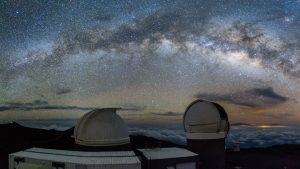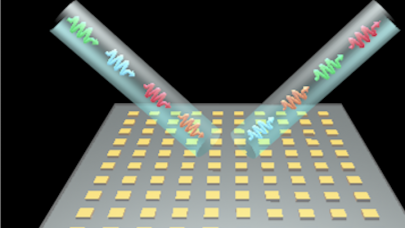March 16, 2023 — Images of deep space have intrigued many a sky-gazer over the course of modern history. The first images from NASA’s Hubble Space Telescope marked a remarkable moment in space exploration and, more recently, the newly captured snapshots of deep space from the James Webb Space Telescope became a news highlight that reached well beyond typical astronomy audiences.

Astrophysicists acquire these images as part of large surveys – systematic studies of large areas of the sky over time and through different parts of the electromagnetic spectrum. These surveys can be designed for different scientific goals such as studying distant galaxies and how they have changed over the history of the universe, looking at specific regions that are especially important like the Andromeda Galaxy or looking for energetic astrophysical “transient” sources such as supernovae, tidal disruption events and kilonovae.
These transients evolve quickly, rising to a maximum and then fading away over days to months. The National Center for Supercomputing Applications’ Center for AstroPhysical Surveys (CAPS) has been deeply involved in the first data release from the Young Supernova Experiment, which began in 2019 surveying more than 1,500 square degrees of sky every three days and discovered thousands of new cosmic explosions and other astrophysical transients, dozens of them just days or hours after explosion.
Taken with the Pan-STARRS1 telescope atop Haleakalā, Hawaii, the data is transferred to the University of Hawaii Information Technology Center for initial processing and calibration. Higher-level processing, detailed analysis and storage is done by computing systems at NCSA, the University of California, Santa Cruz (UCSC) and the Dark Cosmology Centre (DARK) at the Niels Bohr Institute at the University of Copenhagen. Researchers from Pennsylvania State University (PSU) developed algorithms to help classify the data.
It is the largest low-redshift multi-band data release of supernovae ever – slightly fewer than 2,000 objects – and is the first to use photometric classification and photometric redshifts extensively, which is critical for the Vera C. Rubin Observatory Legacy Survey of Space and Time for where there are too many objects to get spectra.
Gautham Narayan, deputy director of CAPS, is leading the cosmological analysis for the data sample and former CAPS graduate fellow Patrick Aleo is lead author of the paper titled, “The Young Supernova Experiment Data Release 1 (YSE DR1): Light Curves and Photometric Classification of 1975 Supernovae.”
“The data release is an important milestone for supernova science and a testament to the hard work of astronomers scattered across the world at all career stages – from undergraduate students to professors, pipeline scientists, observers and more,” Aleo said. “With further study, it will provide insights into the origin of the supernovae, the properties of their progenitor star, and the structure of their host galaxies. I am excited to see it used as a reference point for future surveys and the research that the community produces with this dataset.”
“Much of the time-domain universe is uncharted. We still do not know the progenitor systems of many of the most common classes of transients, such as type Ia supernovae, while still using these sources to try and understand the expansion history of our universe,” Narayan said. “We’ve also seen one electromagnetic counterpart to a binary neutron star merger. There are many kinds of transients that are theoretically predicted, but have never been seen at all.”
“One of the strengths of this dataset is the wide range of transients we can observe,” said Professor Decker French, another member of the YSE collaboration. “By covering a large area in the sky, we can observe rare transient events such as stars being shredded by supermassive black holes.”
“We have already begun to analyze data for interesting transients, not just from supernovae, but from stars and gas falling on to supermassive black holes,” added Nick Earl, a UIUC graduate student and former CAPS fellow.
Many researchers were involved in this project, including another former CAPS graduate fellow Alex Gagliano, current CAPS fellow Amanda Wasserman, CAPS postdoctoral fellow Deep Chatterjee and a handful of other University of Illinois Urbana-Champaign researchers who co-authored the paper.
“Illinois Astronomy has set a strategic goal of increasing science leadership in survey and transient science,” said Professor and Chair of Astronomy Leslie Looney. “This excellent work by Professor Narayan and graduate student Patrick Aleo demonstrates the power of these techniques and the exciting results that are critical for moving forward in our quest to better understand the universe.
CAPS will be hosting a time-domain conference at UIUC June 20-22.
“Positioning ourselves for the next decade in the time-domain and establishing ourselves as leaders in supporting large astrophysical surveys and experiments is a key goal for NCSA/CAPS and the University of Illinois,” added CAPS Director Joaquin Vieira. “Our involvement in the Young Supernova Experiment is yet another step in that direction. YSE continues to build on our expertise with the Dark Energy Survey, the South Pole Telescope and our deep involvement in construction of the Vera C. Rubin Observatory. This conference is intended to bring scientists from these disparate missions together, identify key scientific breakthroughs they can make by working together and enable that science by building the future of astronomical data infrastructure here at CAPS.”
This groundbreaking effort could not have succeeded without the collective partnership between the University of Hawaii, UCSC, DARK, NCSA and UIUC. Using Hawaii’s Pan-STARRS1 telescope to collect the images, DARK’s enhanced processing of the data on its computing cluster, UCSC’s organization of the survey and data hosting, and NCSA and UIUC’s analysis – it is an outstanding achievement for multi-institution research.
“This survey is a discovery portal,” said Ryan Foley, assistant professor of astronomy and astrophysics at UCSC, who led the organization of the YSE survey project. “We are finding thousands of interesting objects, which we can then follow and study with additional observations to understand what we’re seeing.”
“YSE is a tight-knit, worldwide collaboration emphasizing the inclusion of and contributions by young scientists,” said Jens Hjorth, Villum investigator and professor at DARK. “The DR1 is a testament to the pioneering spirit of all those involved.”
“The first data release of YSE is really a testament to the power of collaboration,” said Ashley Villar, an assistant professor in the Department of Astronomy and Astrophysics at PSU and co-hire of the PSU Institute for Computational and Data Science. “Our group at Penn State created one of the classification algorithms used to classify the full sample of nearly 2,000 new supernovae. This would have been impossible without spectra taken from many members of our team and a large grid of simulations from the University of Illinois.”

Mark Huber, a senior researcher at University of Hawaii’s Institute for Astronomy, and deeply involved in the YSE project said, “Pan-STARRS produces a steady stream of transient discoveries, observing large areas of the sky every clear night with two telescopes. With over a decade of observations, Pan-STARRS operates one of the best calibrated systems in astronomy with a detailed reference image of the static sky visible from Haleakalā. This enables rapid discovery and follow up of supernovae and other transient events well suited for programs like YSE to build up the sample required for analysis and this significant data release.”
Director of Pan-STARRS Observatories Ken Chambers added “this collaboration with the Young Supernova Experiment makes exceptional use of Pan-STARRS’ ability to routinely survey the sky for transient phenomena and moving objects. We have provided an unprecedented sample of young supernovae discovered before their peak luminosity that will be an important resource for supernova researchers and cosmologists for many years. Looking ahead, Pan-STARRS will remain a crucial resource in the Northern Hemisphere to complement the Rubin Observatory in the Southern Hemisphere.”
Source: Andrew Helregel, NCSA


























































